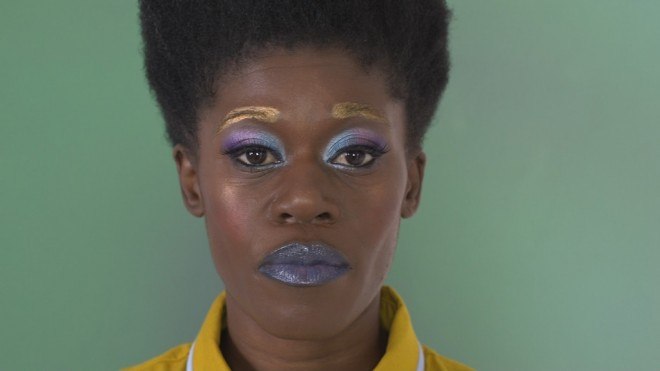Now in its tenth year, the winner of The Jarman Award was announced at Whitechapel Gallery on the 20th November. This year saw Oreet Ashery take home the prize, receiving £10,000 to develop her projects which consider gender and society with the support from Channel 4.
The award recognises artists working with moving image, celebrating and supporting experimental, imaginative and innovative UK-based work. The Jarman Award is named after legendary experimental director and cinematographer Derek Jarman.
Twin spoke to winner Oreet Ashery along with Adham Faramway and Marianna Simnett – both shortlisted for the award.
Adham Faramway’s work draws on the language of advertising and combines it with the transgressive aesthetics of ‘body horror’, Oreet Ashery is an interdisciplinary artist who confronts ideological, social and gender constructions, while Marianna Simnett surgically lowered her own voice with botox during her short film The Needle and the Larynx, which screened on Sunday. Together they represent some of the most exciting filmmakers on the scene today.
Twin meets Oreet Ashery
Why did you choose the web series format for your film Revisiting Genesis?
My work always reaches beyond the structure of the contemporary art institution, but this is my first major work created specifically for the internet so that it can be freely accessible to as wide an audience as possible. I was inspired by the independent filmmaking of web series’ such as F to 7, and wanted to develop my own approach to the genre as a visual artist. Revisiting Genesis aims to conceptually expand the entertaining and narrative driven elements of the format. One of the central questions explored in the work is around what happens to your online digital content (websites, social media profiles, photographs etc) after you die, and as such the internet provides an appropriate platform for the work.
How does Revisiting Genesis force viewers to consider their own mortality and their online legacies?
Hopefully it makes them think and contemplate whether they want to put anything in place in preparation for death (expected and unexpected) and if so what and how.
How does the film expand on some of the key ideas you have been exploring in your practice?
The film expands on the notion of a potential community, in the real sense that most of the people in the work know each other from the art and performance world. The fictional narrative speaks about a community of friends, outside normative family structures, that come together to help Genesis. I think a lot about how we can structure our busy lives so we can have space to help a friend if needed. The other issue that comes up in the film is the loss of social structures, such as the community college Charles Keene in Leicester, it was the first place I felt a sense of belonging as a young immigrant to the UK in the late 80s. the College has been demolished in 2010 and has been amalgamated to a multi campus university, as is the faith of most community colleges. After the films I received great emails from people who were outsiders and use to go there and achieved so much in their lives since. The emails mentioned what an important role this college played in their development. The other aspect, and there are many, is the idea of one’s identity or the narration of one’s life, in this film I’ve expanded this notion to the afterlife.
What do you hope viewers will take away from Revisiting Genesis?
I have no expectations as such. What I always hope people well take away from my work is something that lingers, that is not easy and that makes them think.
Twin meets Adham Faramawy
Where does the title of your film, Janus Collapse, come from?
The time that I was working on the video that’s shortlisted for the Jarman award was both personally and politically pretty unstable. I was recovering from a minor a road accident and
TV and social media were (and still are!) saturated with adverts and disaster politics. I was kind of trapped at home, looking at this stuff, reading sci-fi and feeling introspective. I had to think through some things while researching for the show at Bluecoat in Liverpool. Where the piece would first
be seen. I wanted to think through this instability, to think as an image-maker about how images are used to introduce and reinforce certain ideas. I wanted to examine the ways that images are disseminated and to consider what effect that has on me personally and whether it affected how I was thinking about my body.
The Janus is the two faced Roman god of doorways and transition. I decided to use his image as something to hang this examination of instability on, while casting the idea of a collapse as something generative, the possibility of the collapse of an image.
How does the film subvert tropes that are used in advertising?
In a way I consider almost all my output as a kind of contamination of aesthetic categories. I feel uncomfortable with hierarchies and I just don’t like being told who I am or what to do, so my interest in advertising is in a sense symptomatic of that sense of always wanting to investigate
and push back. The way that I’ve been investigating commercial images is to try to inhabit them, mimic them, intensify and distort certain aspects until they no longer possess a commercial potential.
When did you start incorporating the ‘body horror’ genre into your work?
Writer Jamie Sutcliffe pointed it out to me in an interview! He said, “We see a pair of hands moisturizing with a digitally enhanced, absurd and all-consuming slime. It’s a quick slip from Evian commercial to a kind of Cronenbergian symbiosis.”At that point I started looking for body horror in adverts and realized that images of melting teenagers were being used to sell pizza and escaped tongues were being used to sell beer.
It was Octavia Butler’s Xenogenesis Trilogy that introduced me to the idea of body horror as one facet of a potentially holistic, tender, nurturing, non-binary sexual experience.
What do you hope viewers will take away from the film?
I hope that viewers take away a feeling complicated and queasy enough to highlight the operative mechanisms of the image they’ve just ingested.
Twin meets Marianna Simnett
The Needle and the Larynx was screened on Sunday – what was the inspiration behind that film?
A sudden, terrible urge to lower my voice, a fascination with toxins and hypodermic needles, and a desire to warp my experience into a fable.
Why is it important for you to put yourself into your work, and to test the limits of your own body?
I can take risks with my own body I wouldn’t take with others. It’s my go-to tool for telling stories, and helps me to live out my ideas and not just think about them. At best, my work might prompt someone to cup their genitals or necks, as if to check they are materially, unmistakably present. That liminal space between being a thing or a someone, and then morphing or falling apart – I’m hooked on those moments.
You have often explored the gendered implications of voice and masochism, what draws you to these themes?
I’m interested in appropriating and spoiling archetypes, especially when it comes to the final binary constraints of heteronormativity. Pitch, tone, timbre and accent have implications on social bodies and their right to exist in one place and not another. Voices (often disembodied) in my work battle patriarchy and madness. Masochism is a submission to fantasy.


 PREVIOUS
PREVIOUS

 Twitter
Twitter
 Tumblr
Tumblr
 YouTube
YouTube
 Facebook
Facebook
 Instagram
Instagram
